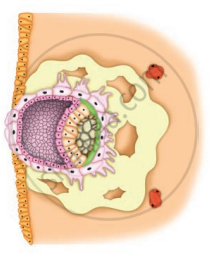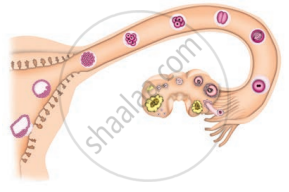Advertisements
Advertisements
Question
The daughter cells produced by asexual reproduction are genetically identical to the parent cell.
Options
True
False
Solution
The daughter cells produced by asexual reproduction are genetically identical to the parent cell : True
APPEARS IN
RELATED QUESTIONS
Define reproduction.
What is DNA?
Why is DNA copying an essential part of the process of reproduction?
Egg laid after fertilisation is made up of a single cell.
A spore-producing organism is ______.
What is the name of the reproductive process :
which involves two parents?
Write down the different methods of asexual reproduction.
Why are budding, fragmentation and regeneration, all considered to be asexual type of reproduction?
Fill in the following blank with suitable word :
the process of...........ensures continuity of life on earth.
What is the basic difference between asexual reproduction and sexual reproduction?
What is a clone? Why do offsprings formed by asexual reproduction exhibit remarkable similarity?
Match the organisms given in column I with the methods of reproduction/propagation given in column II :
| Column I | Column II | |
| (i) Plasmodium | (a) Spore formation | |
| (ii) Spirogyra | (b) Leaves | |
| (iii) Jasmine | (c) Regeneration | |
| (iv) Apple tree | (d) Budding | |
| (v) Bryophyllum | (e) Binary fission | |
| (vi) Potatoes | (f) Layering | |
| (vii) Rhizopus | (g) Fragmentation | |
| (viii) Hydra | (h) Tubers | |
| (ix) Planaria | (i) Cuttings | |
| (x) Leishmania | (j) Multiple fission | |
| (xi) Sugar cane | (k) Grafting | |
| (xii) Rose |
What are the two general methods of reproduction in organisms?
Asexual reproduction is :
(a) a fusion of specialised cells
(b) a method by which all types of organisms reproduce
(c) a method producing genetically identical offspring
(d) a method in which more than one parent are involved
Name two animals which undergo internal fertilisation?
State whether the following statement is true (T) or false (F):
Dogs and cats reproduce from two parents.
List any two different forms asexual reproduction.
What is the role of the seminal vesicles and the prostate gland?
Match the following:
| Column ‘I’ | Column ‘II’ |
|
(1) Inhibits plant growth
|
(a) Breaks large fat globules into smaller ones
|
|
(2) Cytokinins
|
(b) Auxins
|
|
(3) Cellular respiration
|
(c) Mitochondria
|
|
(4) Bile
|
(d) Promote cell division
|
|
(e) Abscisic acid
|
Explain the term Reproduction.
By which process do green plants synthesize their food?
Name the factors which take part in this process.
Answer the following question.
The growing size of the human population is a cause of concern for all people. The rate of birth and death in a given population will determine its size. Reproduction is the process by which organisms increase their population. The process of sexual maturation for reproduction is gradual and takes place while general body growth is still going on. Some degree of sexual maturation does not necessarily mean that the mind or body is ready for sexual acts or for having and bringing up children. Various contraceptive devices are being used by human beings to control the size of the population.
(a) List two common signs of sexual maturation in boys and girls.
(b) What is the result of reckless female foeticide?
(c) Which contraceptive method changes the hormonal balance of the body?
(d) Write two factors that determine the size of a population.
Multiple choice question.
Insect pollinated flowers usually posses ______
Multiple choice question.
Point out the odd one.
The number of nuclei present in a zygote is _______.
The number of meiotic and mitotic divisions necessary for development of female gametophyte in angiosperms is ______.
Self-incompatibility is found in flowers of plants _______.
The single shield-shaped cotyledon in monocot seed is known as ______.
Explain heterostyly and herkogamy with suitable example.
Seminal fluid is ______ in nature.
Which of the following is not a part of the uterus?
Nervous system develops from ______ of embryonic layer.
What is morula?
Match the following.
| Column I | Column II |
| Fission | Spirogyra |
| Budding | Amoeba |
| Fragmentation | Yeast |
Name two organisms that reproduce through budding.
Observe the following figures.
 |
 |
 |
|
| (a) | (b) | (c) | (d) |
- Identify the stages (a) to (d) in figure during development of human baby.
- Arrange the stages in correct sequence of development.
- Explain the development that takes place in any one stage.

